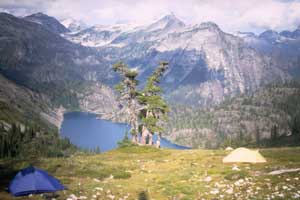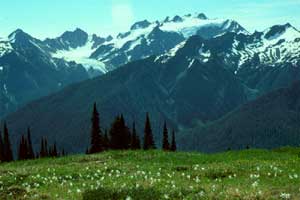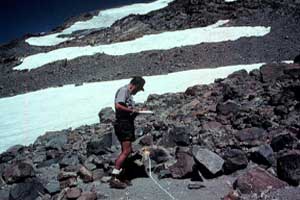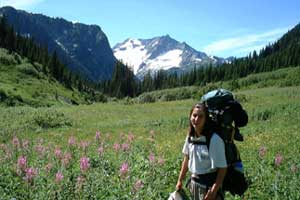|
Research Catalog
A comprehensive manual of natural and cultural study opportunities within Mount Rainier, North Cascades, and Olympic National Parks |

|
 |
 |
 |
 |
Wilderness Management

Background
Protection of wilderness values is an important facet of park management
in the Pacific Northwest. The 1988 Washington Wilderness Act designated
97% of Mount Rainier National Park, 93% of North Cascades National Park
Service Complex, and 95% of Olympic National Park as wilderness.
Wilderness or Backcountry Management Plans guide and direct the
preservation, use and restoration of each park's wilderness (National
Park Service, 1989; Samora, 1989; National Park Service, 1980).
Resource conditions are monitored using indicators and standards
selected under Limits of Acceptable Change protocols (Stankey et al.,
1985). Although indicators and standards were selected to reflect
aesthetic, ecological, and experiential wilderness values, limited
research was available to select or validate these criteria.
Concern over rising visitation in parks and accompanying impacts on resources and the visitor experience has led the NPS to focus increasing attention on the concept of carrying capacity. The NPS has developed the Visitor Experience and Resource Protection (VERP) planning framework (NPS 1997). VERP focuses on visitor use impacts on the visitor experience and the park's resources. These impacts are primarily focused on visitor behavior, use levels, types of use, timing of use, and location of use. Research is needed to assist managers in selecting sensitive VERP indicators and developing quantitative standards that reflect temporal and spatial factors, are impact-oriented and realistic.
Research is needed to determine how current LAC or VERP indicators are linked to ecological integrity, re-evaluate indicator selection, and better understand the influence of recreational use on wilderness conditions.
Park Focus: MORA, NOCA, OLYM
Research Needs
When does human use threaten ecosystem integrity? At what scale should
these questions be addressed?
Does recreational use fragment ecosystems? Are maps of bare ground impacts (such as social trails and campsites) an appropriate way to monitor fragmentation? Are there new methods or developments in high-resolution aerial photography or remote sensing that could be used to monitor fragmentation?
Can older aerial photographs be used to document landscape change in heavily used areas of each park? Areas of particular interest are Spray Park and Muir Corridor in Mount Rainier National Park, Boston Basin in North Cascades National Park and Seven Lakes Basin in Olympic National Park.
How does recreational use influence community process and function? What is the influence of recreational use on hydrologic processes, plant reproduction and dispersal, pollination, nutrient cycling, invertebrate community composition and function, or wildlife? What is the limiting factor for different components of park ecosystems?
Is social trail density or width more important when assessing their influence on populations of interest (for example see Miller et al, 1998)? Is presence of social trails or level of use more important for wildlife populations?
We would like to compare results from the application of multiple indices in targeted areas to evaluate their application for long-term monitoring and description of the impacts of recreational use on ecological integrity. Some approaches that could be considered are index of biotic integrity (Karr et al., 1986), cryptobiotic soil conditions and nutrient cycling (Belnap, 1998), soil loss, condition class surveys versus bare ground (Frissell, 1978, Rochefort and Swinney, in press), and impacts on wildlife.
What are the most effective and feasible methods for monitoring visitor use?
What are the proportions of day-users to overnight users within different areas of the parks?
How do use patterns (such as dispersal, activities) differ between day-users and overnight users and how do these patterns relate to visitor impacts on park ecosystems? ( for examples see Hospodarsky et al, 1988 and Johnson and Swearingen, 1988).
Who are our visitors to wilderness areas? What are their expectations for park visits? Are there differences between visitors who come on commercial trips versus those who come independently (e.g. visitor expectations, preferences, demographics, trip objectives, etc.)?
Detection and assessment of the effects of human waste on park ecosystems.
Development of the most effective methods to dispose of human waste given specific environmental conditions.
Resources Available
Mount Rainier National Park: GIS maps of all impacts in
cross-country zones are available for data collected 1984 to the
present. Quantitative measurements of cross-country zone impacts and
trailside camps, and associated impacts, are available. Photographs of
most of the impacts and stereo pair aerial photos at 1:24,000 scale for
1984 and 1988.
North Cascades National Park: GIS maps of social trails and campsites in cross-country zones are available. Quantitative measurements are available for trailside camps and many of the cross-country zone maps.
Olympic National Park: Quantitative measurements of campsite-related impacts aer available for all established wilderness campsites. Visitor experience data is available for campsite use and visitor encounters along trails. A 1998 social science study provides information on overnight wilderness user demographics, preferences and trip characteristics.
References Cited
Belnap, J. 1998. Choosing indicators of natural resource condition: a
case study in Arches National Park, Utah, USA. Environmental Management
22(4): 635-642.
Frissell, S. S. 1978. Junding recreation impacts on wilderness campsites. Journal of Forestry, August: 481-483.
Hospodarsky, D., K. Martinson, and D. Field. 1988. Human use of high lakes: A literature review. Oregon State University Cooperative Park Service Unit, 122 p.
Johnson, D. R. and T. C. Swearingen. 1988. Minor rule violators: A profile of off-trail hikers, Paradise Meadows, Mount Rainier National Park Research Paper CA-9000-3-0004-10.
Karr, J.R., K.D. Fausch, P. L. Angermeier, P. R. Yant, and I. J. Schlosser. 1986. Assessiong biological integrity in running waters: A method and its rationale. Illinois Natural History Survey, Special Pub. 5, Champaign, Illinois.
Miller, S. G., R. L. Knight, and C. K. Miller. 1998. Influence of recreational trails on breeding bird communities. Ecological Applications 8(1): 162-169.
National Park Service, 1997. The Visitor Experience and Resource Protection (VERP) Framework: A Handbook for Managers. U.S. Department of Interior, National Park Service, Denvers Service Center. 102 p.
National Park Service, 1980. Backcountry Management Plan, Olympic National Park, Port Angeles, WA, 48 p.
National Park Service, 1989. Wilderness Management Plan, North Cascades National Park Service Complex, Sedro-Woolley, WA, 70 p.
Rochefort, R. M. and D. D. Swinney. 2000. Human impact surveys in Mount Rainier National Park: Past, Present and Future. In press. Proceedings of the 1999 Wilderness Research Conference. U. S. D. A. Forest Service.
Samora, B. A. 1989. Wilderness Management Plan, Mount Rainier National Park, Ashford, WA, 121 p.
Stankey, G. H., D. N. Cole, R. Lucas, M. E. Petersen, S. Frissell. 1985. The Limits of Acceptable Change (LAC) System for Wilderness Planning. U.S.D.A. Forest Service. General Technical report INT-176. Intermountain Forest and Range Experiment Station. Ogden. UT. 37p.
Rev. 9/2000
| <<< Previous | <<< Contents>>> | Next >>> |
research-catalog/wilderness.htm
Last Updated: 05-Sep-2000